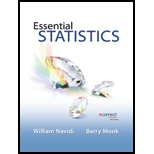
Concept explainers
a.
Compute the probability that a randomly selected worker is a college graduate.
a.
Answer to Problem 1CYU
The probability that a randomly selected worker is a college graduate is 0.342.
Explanation of Solution
Calculation:
The U.S workers are classified based on type of occupation and education level. The table provides the frequency in thousands for each category.
The probability of the
Here, event V denotes that selected worker is a college graduate. Event V consist all the college graduates with any type of occupation.
Therefore,
Substitute 43,181,000 for “number of outcomes in V” and 126,172,000 for “Number of outcomes in
Therefore,
Thus, the probability that a randomly selected worker is a college graduate is 0.342.
b.
Compute the probability that the occupation of randomly selected worker is either sales and office or production and transportation.
b.
Answer to Problem 1CYU
The probability that the occupation of randomly selected worker is either sales and office or production and transportation is 0.361.
Explanation of Solution
Calculation:
Event V denotes that selected worker’s occupation is sales and office and event W denote that selected worker’s occupation is production and transportation. Event V and W are mutually exclusive since the worker can choose any one of the occupation. Event V contains workers who are college graduates and his or her occupation is sales and office and workers who are non-college graduates and his or her occupation is sales and office. Event W contains workers who are college graduates and his or her occupation is production and transportation and workers who are non-college graduates and his or her occupation is production and transportation.
The probability that the occupation of selected worker is either sales and office or production and transportation can be expressed as,
For two mutually exclusive events V and W the addition rule states that
From table, total number of workers of Sales and office is,
Therefore,
Substitute these values in the addition rule.
Therefore,
Thus, the probability that the occupation of selected worker is either sales and office or production and transportation is 0.361.
c.
Compute the probability that the occupation of selected worker is either a college graduate or has a service occupation.
c.
Answer to Problem 1CYU
The probability that the occupation of selected worker is either a college graduate or has a service occupation is 0.469.
Explanation of Solution
Calculation:
Event V denotes that selected worker is a college graduate and event W denotes that selected worker has a service occupation. Event W contains workers who are college graduates and has a service occupation and workers who are non-college graduates and has a service occupation.
The probability that the occupation of selected worker is either a college graduate or has a service occupation can be expressed as,
From table, total number of workers of service occupation is,
General Addition rule:
For any two events V and W the general addition rule states that
From part (a),
From table
Substitute these values in the general addition rule.
Therefore,
Thus, the probability that the occupation of selected worker is either a college graduate or has a service occupation is 0.469.
Want to see more full solutions like this?
Chapter 4 Solutions
Essential Statistics
 MATLAB: An Introduction with ApplicationsStatisticsISBN:9781119256830Author:Amos GilatPublisher:John Wiley & Sons Inc
MATLAB: An Introduction with ApplicationsStatisticsISBN:9781119256830Author:Amos GilatPublisher:John Wiley & Sons Inc Probability and Statistics for Engineering and th...StatisticsISBN:9781305251809Author:Jay L. DevorePublisher:Cengage Learning
Probability and Statistics for Engineering and th...StatisticsISBN:9781305251809Author:Jay L. DevorePublisher:Cengage Learning Statistics for The Behavioral Sciences (MindTap C...StatisticsISBN:9781305504912Author:Frederick J Gravetter, Larry B. WallnauPublisher:Cengage Learning
Statistics for The Behavioral Sciences (MindTap C...StatisticsISBN:9781305504912Author:Frederick J Gravetter, Larry B. WallnauPublisher:Cengage Learning Elementary Statistics: Picturing the World (7th E...StatisticsISBN:9780134683416Author:Ron Larson, Betsy FarberPublisher:PEARSON
Elementary Statistics: Picturing the World (7th E...StatisticsISBN:9780134683416Author:Ron Larson, Betsy FarberPublisher:PEARSON The Basic Practice of StatisticsStatisticsISBN:9781319042578Author:David S. Moore, William I. Notz, Michael A. FlignerPublisher:W. H. Freeman
The Basic Practice of StatisticsStatisticsISBN:9781319042578Author:David S. Moore, William I. Notz, Michael A. FlignerPublisher:W. H. Freeman Introduction to the Practice of StatisticsStatisticsISBN:9781319013387Author:David S. Moore, George P. McCabe, Bruce A. CraigPublisher:W. H. Freeman
Introduction to the Practice of StatisticsStatisticsISBN:9781319013387Author:David S. Moore, George P. McCabe, Bruce A. CraigPublisher:W. H. Freeman





